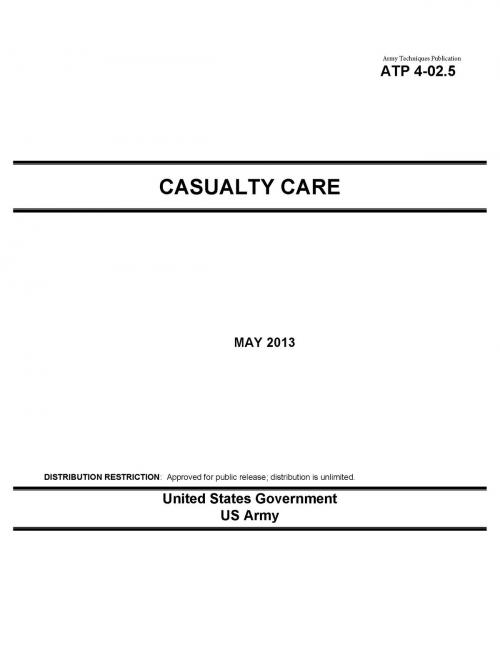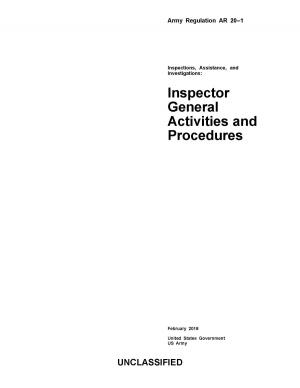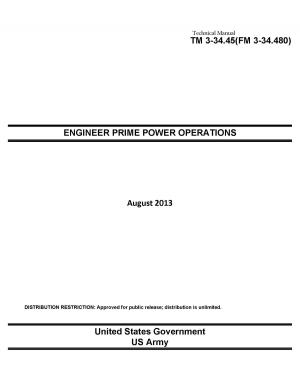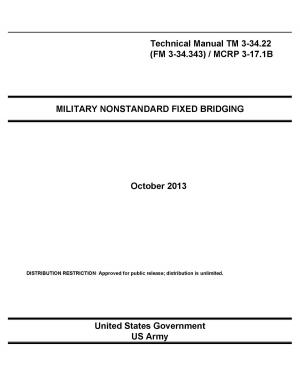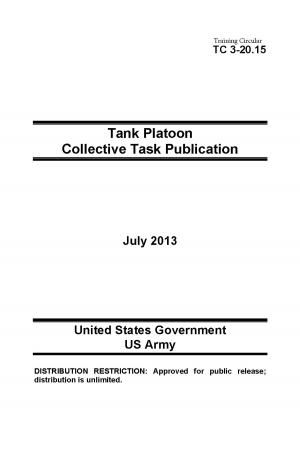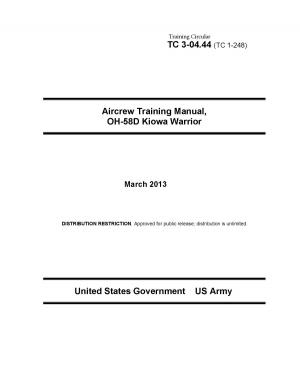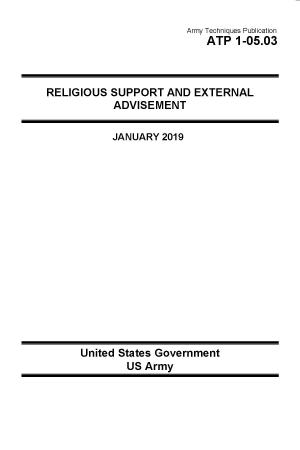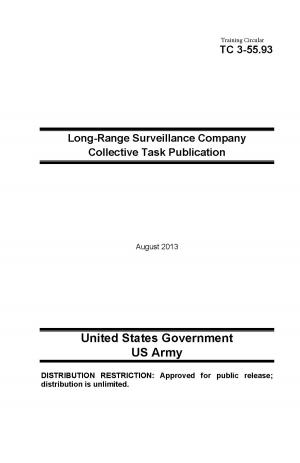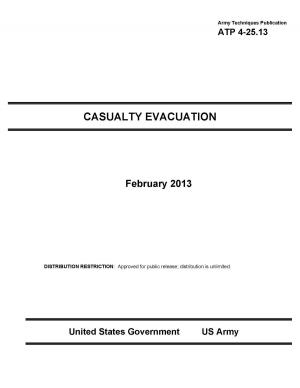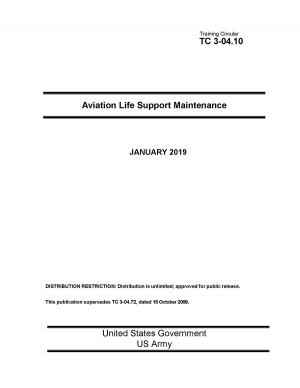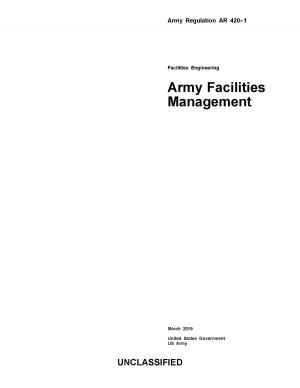Army Techniques Publication ATP 4-02.5 Casualty Care May 2013
Nonfiction, Health & Well Being, Medical, Patient Care, Caregiving, Reference, Administration, Nutrition| Author: | United States Government US Army | ISBN: | 1230000137594 |
| Publisher: | eBook Publishing Team | Publication: | June 1, 2013 |
| Imprint: | Language: | English |
| Author: | United States Government US Army |
| ISBN: | 1230000137594 |
| Publisher: | eBook Publishing Team |
| Publication: | June 1, 2013 |
| Imprint: | |
| Language: | English |
This Army techniques publication (ATP) is a consolidation of currently existing publications which address the treatment aspects of the Army Health System (AHS). The publications being consolidated into this ATP publication include: Field Manual (FM) 4-02.10, 3 January 2005; FM 4-02.19, 31 July 2009; FM 4-02.25, 28
March 2003; FM 4-02.51, 6 July 2006; and FM 4-02.56, 6 July 2006. This publication is intended for use by commanders and their staffs, command surgeons, AHS planners, and Army Medical Department personnel and units.
This publication addresses the casualty care aspects of the health service support mission under the sustainment warfighting function. It describes the various organizational designs for the units providing this support and doctrinal guidance on the employment of these organizations and their functional capabilities.
The staffing and organizational structures and positions presented in this manual are established in tables of organization and equipment (TOEs). These tables were current at the time this manual was published. The organization of these units is subject to change in order to comply with manpower requirements criteria outlined in Army Regulation (AR) 71-32. These organizations are also subject to change at the unit level in order to meet wartime requirements and changes are reflected in the units’ modified table of organization and equipment (MTOE).
The AHS is comprised of a system of interrelated and interdependent systems synchronized to provide a
seamless continuum of care from the point of injury, wounding, or illness in a deployed area of operations (AO), through successive increments of greater capability and complexity to definitive, convalescent, and rehabilitative care in the continental United States (CONUS)-support base. Historically, the systems have been referred to as medical functions and include: medical mission command; medical treatment (area and organic support); hospitalization; dental services; preventive medicine services; veterinary services; combat and operational stress control (COSC); medical evacuation (to include medical regulating and en route medical care); medical logistics (to include blood management); and medical laboratory services.
With the publication of FM 3-0 in February 2008, the missions of the AHS were placed under two different warfighting functions, where previously they had only been included in the combat service support battlefield operating system. The two warfighting functions which now contain AHS missions are the sustainment warfighting function and the protection warfighting function. The transition from the battlefield operating systems to the warfighting functions required a new approach in describing the capabilities of the Army Medical Department.
Under the sustainment warfighting function, the mission to provide health service support is comprised of three major components—casualty care, medical evacuation, and medical logistics. Casualty care encompasses medical treatment (organic and area support), hospitalization, the treatment aspects of dental services and combat and operational stress (behavioral health and neuropsychiatric care), and clinical laboratory services. It also includes the treatment of chemical, biological, radiological, and nuclear (CBRN)-contaminated patients.
Under the protection warfighting function, the mission to provide force health protection is comprised of preventive medicine, veterinary services, the preventive aspects of dental services (preventive dentistry) and combat and operational stress control, and the area medical laboratory.
This Army techniques publication (ATP) is a consolidation of currently existing publications which address the treatment aspects of the Army Health System (AHS). The publications being consolidated into this ATP publication include: Field Manual (FM) 4-02.10, 3 January 2005; FM 4-02.19, 31 July 2009; FM 4-02.25, 28
March 2003; FM 4-02.51, 6 July 2006; and FM 4-02.56, 6 July 2006. This publication is intended for use by commanders and their staffs, command surgeons, AHS planners, and Army Medical Department personnel and units.
This publication addresses the casualty care aspects of the health service support mission under the sustainment warfighting function. It describes the various organizational designs for the units providing this support and doctrinal guidance on the employment of these organizations and their functional capabilities.
The staffing and organizational structures and positions presented in this manual are established in tables of organization and equipment (TOEs). These tables were current at the time this manual was published. The organization of these units is subject to change in order to comply with manpower requirements criteria outlined in Army Regulation (AR) 71-32. These organizations are also subject to change at the unit level in order to meet wartime requirements and changes are reflected in the units’ modified table of organization and equipment (MTOE).
The AHS is comprised of a system of interrelated and interdependent systems synchronized to provide a
seamless continuum of care from the point of injury, wounding, or illness in a deployed area of operations (AO), through successive increments of greater capability and complexity to definitive, convalescent, and rehabilitative care in the continental United States (CONUS)-support base. Historically, the systems have been referred to as medical functions and include: medical mission command; medical treatment (area and organic support); hospitalization; dental services; preventive medicine services; veterinary services; combat and operational stress control (COSC); medical evacuation (to include medical regulating and en route medical care); medical logistics (to include blood management); and medical laboratory services.
With the publication of FM 3-0 in February 2008, the missions of the AHS were placed under two different warfighting functions, where previously they had only been included in the combat service support battlefield operating system. The two warfighting functions which now contain AHS missions are the sustainment warfighting function and the protection warfighting function. The transition from the battlefield operating systems to the warfighting functions required a new approach in describing the capabilities of the Army Medical Department.
Under the sustainment warfighting function, the mission to provide health service support is comprised of three major components—casualty care, medical evacuation, and medical logistics. Casualty care encompasses medical treatment (organic and area support), hospitalization, the treatment aspects of dental services and combat and operational stress (behavioral health and neuropsychiatric care), and clinical laboratory services. It also includes the treatment of chemical, biological, radiological, and nuclear (CBRN)-contaminated patients.
Under the protection warfighting function, the mission to provide force health protection is comprised of preventive medicine, veterinary services, the preventive aspects of dental services (preventive dentistry) and combat and operational stress control, and the area medical laboratory.
